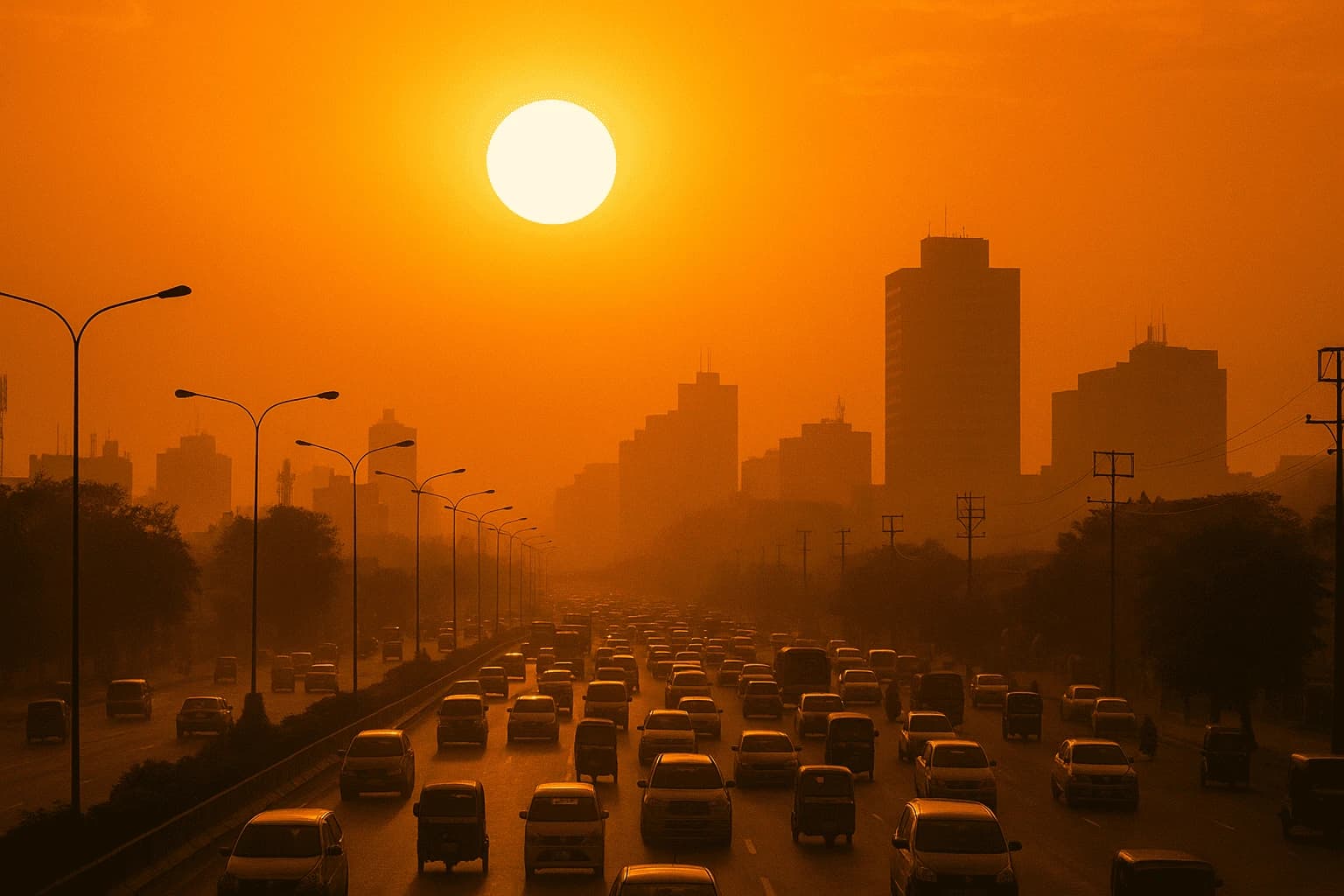© 2025 Roz UpdatesbyTETRA SEVEN

* All product/brand names, logos, and trademarks are property of their respective owners.
In the scorching summer of 2025, the province of Punjab, Pakistan, has been gripped by one of the most intense heatwaves in its history. Temperatures soared to a staggering 49°C, breaking historical records and pushing the region into a state of severe weather emergency. This unprecedented heatwave has not only disrupted daily life but also spotlighted the escalating impacts of climate change in South Asia.
The sweltering conditions have affected millions across key cities including Lahore, Multan, Bahawalpur, Faisalabad, Sialkot, and Bhakkar, where the mercury approached or exceeded dangerously high thresholds. Public health officials have issued urgent warnings as hospitals report an increase in heatstroke cases, dehydration, and other heat-related illnesses. Meanwhile, the Provincial Disaster Management Authority (PDMA) and the Pakistan Meteorological Department (PMD) have issued red alerts, urging people to stay indoors and avoid direct sunlight during peak hours.
As this extreme weather event unfolds, it serves as a stark reminder of the vulnerability of the region to climatic extremes. Power outages, water shortages, and stressed infrastructure have amplified the crisis, leaving communities struggling to cope. Farmers face crop failures and livestock losses, while urban dwellers are battling blackouts and dwindling resources.
This blog delves deep into the Punjab heatwave of 2025, analyzing its causes, impact, and the response from authorities. We’ll explore how different cities are coping, the scientific backdrop driving these climatic shifts, and what can be done to mitigate future disasters. In a world where record-breaking temperatures are becoming the norm, this heatwave is not just a weather anomaly—it is a call to action.
The Punjab heatwave of 2025 emerged as one of the most extreme weather phenomena in Pakistan’s recent history. Fueled by a combination of high-pressure systems, declining vegetation, and urban sprawl, the temperatures in multiple cities surpassed 49°C, shattering long-standing climatic norms. What began as an early summer surge quickly evolved into a persistent, brutal heatwave that tested the limits of human and environmental endurance.
The Pakistan Meteorological Department (PMD) began observing unusual thermal activity in late May, with forecasts indicating prolonged high temperatures due to stagnant atmospheric patterns. A ridge of high pressure over northern India and Pakistan inhibited cloud formation and blocked cooler air masses, causing heat to accumulate and intensify across Punjab.
Satellite imagery and ground-based temperature logs reported record highs consistently between June 3rd and June 12th, with Bhakkar, Dera Ghazi Khan, and Bahawalpur registering some of the highest figures close to 50°C. Nighttime temperatures also remained unusually high, offering little relief and exacerbating heat stress for residents.
Late May: Initial alerts by PMD on rising temperatures.
June 1–5: Red alerts issued in Multan, Sialkot, and Faisalabad.
June 6–10: Peak intensity; Lahore hits 47°C, while rural districts cross 48–49°C.
June 11 onwards: Slight cooling due to westerly wind patterns, but alerts remain.
Compared to previous years, 2025 has set new benchmarks. In 2022, the hottest recorded temperature in Punjab was 46.1°C, while in 2015, a major heatwave in Karachi resulted in over 1,200 deaths. While fatalities in 2025 remain unconfirmed, the magnitude and reach of this year's heatwave have surpassed all previous records in terms of geographic spread and intensity.
This overview sets the stage for understanding how these extreme temperatures have affected urban and rural life across Punjab.
The 2025 heatwave in Punjab has left a devastating mark on several major cities, each grappling with unique challenges intensified by the relentless temperatures. With many regions reporting temperatures exceeding 49°C, the impact has varied from health emergencies to infrastructure breakdowns. Here's a closer look at the most critically affected urban and rural centers:
| City/Region | Peak Temperature | Key Impacts | Special Notes |
|---|---|---|---|
| Lahore | 47°C | Power outages, overwhelmed hospitals, public service slowdowns | Urban heat island effect intensified discomfort overnight |
| Multan | 48.6°C | Emergency admissions rise, heat exhaustion among outdoor workers | Nishtar Hospital reported extreme patient influx |
| Bahawalpur | 49.2°C | Livestock deaths, dehydration in fields, fire risk in dry crops | Agriculture sector hit hardest |
| Faisalabad | 46.5°C | Factory shutdowns, power instability, water demand spikes | Textile industry interruptions noted |
| Sialkot | 45.8°C | Water supply issues, reduced factory output | Relief centers set up for outdoor laborers |
| Bhakkar | ~50°C | Rural health distress, no access to clean water | One of the worst-hit, lacking cooling centers |
| D.G. Khan | 48.8°C | Medical facility overload, fuel shortages for generators | Civil society relief efforts ongoing |
| Layyah | 48.3°C | Crop wilting, increased respiratory problems | Poor air quality observed |
| Rahim Yar Khan | 48.9°C | Children and elderly severely affected, school closures | Temporary shelters set up in mosques |
| Vehari | 47.6°C | Local power grid collapse, rising heatstroke cases | PMD issued special weather bulletin |
| Okara | 46.2°C | Disrupted public transport, water tanker shortages | Commuters advised to stay off roads during peak hours |
| Jhang | 47.3°C | Agricultural losses, dehydrated canal systems | Farmers protested delayed government intervention |
| Toba Tek Singh | 46.8°C | Limited medical access, rise in seasonal illnesses | NGOs distributed ORS and cold water packets |
| Mianwali | 48.1°C | Infrastructure stress, fan and AC demand surge | Frequent electrical transformer failures |
| Sahiwal | 47.2°C | Mental health complaints, increase in indoor accidents due to dizziness | Rural areas most affected due to housing conditions |
The Punjab heatwave of 2025 has triggered a multi-dimensional crisis, deeply affecting society’s basic functions and the province’s already strained infrastructure. As temperatures peaked close to 49–50°C across various regions, the systemic impact on everyday life became severe and, in some cases, life-threatening.
One of the earliest and most widespread effects was on the electricity supply. The massive spike in demand due to air conditioner and fan usage overwhelmed local grids, leading to prolonged load shedding across urban and rural Punjab. Lahore, Faisalabad, and Multan saw outages lasting 8–12 hours per day, disrupting businesses, homes, and critical services. Transformer blowouts in Mianwali and Vehari left entire neighborhoods in darkness during peak hours, compounding the risk of heatstroke and dehydration.
The soaring temperatures also caused water reservoirs to evaporate faster, drastically reducing supply levels. With limited running water, many regions, especially Bhakkar, Rahim Yar Khan, and Layyah, faced acute clean water scarcity. Tanker services were either insufficient or delayed, with many families waiting in long queues under direct sunlight. This water stress had a cascading effect on sanitation, increasing risks of waterborne illnesses.
Health infrastructure was hit hard. Hospitals in Multan, Bahawalpur, and Sahiwal were stretched to their limits. Thousands of cases of heatstroke, exhaustion, dehydration, and fainting were reported within days. Makeshift emergency tents were erected in parking lots and public grounds to accommodate overflow patients. Many primary healthcare centers in rural areas remained non-operational due to the lack of cooling systems and staff fatigue.
Farmers suffered major losses as wheat, sugarcane, and cotton crops withered under the intense heat. Livestock mortality was reported in Toba Tek Singh and Layyah, impacting food supply chains. Additionally, urban commerce declined as shopkeepers in cities like Sialkot and Okara closed early to avoid peak heat. The economic slowdown from reduced working hours, logistics hurdles, and spoiled perishable goods added to financial burdens.
Heat-damaged roads, melting tar, and engine failures caused traffic slowdowns in cities like Lahore and Sahiwal. Public transportation faced breakdowns, and drivers were advised to avoid long commutes. In Faisalabad, several heat-related vehicle accidents were reported, with authorities urging people to postpone non-essential travel.
From power and water systems to health and agriculture, the 2025 heatwave has exposed Punjab’s vulnerabilities. Without systemic resilience and sustainable urban planning, future climate shocks could cause even deeper societal fractures.
As the heatwave crisis intensified, the Government of Punjab, in coordination with national bodies like the Pakistan Meteorological Department (PMD) and Provincial Disaster Management Authority (PDMA), scrambled to implement emergency response protocols. Though efforts were visible in various cities, the response efficiency varied, leaving some areas dangerously underserved.
The PMD began issuing heatwave red alerts in late May 2025. Using meteorological modeling, it identified high-risk districts including Multan, Bhakkar, Rahim Yar Khan, and Bahawalpur. Alerts were broadcast via radio, television, and social media, with advisories urging people to avoid outdoor activity between 11 a.m. and 4 p.m., stay hydrated, and seek shade.
However, many residents, particularly in rural areas, reported not receiving timely warnings, due to weak digital penetration and inconsistent media access. In remote districts like Mianwali and Layyah, people were caught unprepared as local governments failed to relay alerts effectively.
In urban centers, the Health Department launched emergency response units in Lahore, Faisalabad, and Multan. These included:
Temporary cooling shelters in community centers and schools
Mobile hydration clinics distributing oral rehydration salts and bottled water
Expanded emergency room capacity in hospitals like Nishtar and Mayo
In rural Punjab, however, many such facilities were absent. Where set up, cooling centers were poorly equipped or inadequately staffed. NGOs like Edhi Foundation and Rescue 1122 stepped in to fill the gap, providing ice, tents, and ambulatory care in areas like Toba Tek Singh and Sahiwal.
Despite official efforts, the government faced criticism over its preparedness and inequitable distribution of resources. Civil society groups and local journalists pointed out:
Lack of heatwave awareness campaigns in vulnerable districts
Inadequate funding for rural health centers
Delayed activation of NDMA and PDMA coordination cells
A major concern was the absence of heatwave adaptation policies in local development planning. Unlike flood preparedness, extreme heat remains a neglected area in Punjab’s climate resilience framework.
While some progress was made through emergency services and alerts, the 2025 heatwave highlighted a persistent gap in strategic disaster planning, especially for underserved regions.
The Punjab heatwave of 2025 stands as one of the most extreme and alarming episodes in the province’s recent history. With temperatures surging to an unprecedented 49–50°C, this disaster has disrupted lives, strained healthcare, destabilized infrastructure, and once again exposed the cracks in Pakistan’s climate resilience framework.
Cities like Lahore, Multan, Bahawalpur, Bhakkar, and Faisalabad became battlegrounds of survival, where hospitals filled to capacity, electricity grids faltered, and entire communities scrambled for clean water. While the PDMA and PMD attempted to issue alerts and establish relief centers, many rural and underserved regions remained outside the safety net—left to endure the brutal heat with minimal resources.
Beyond the immediate destruction, this heatwave must be viewed as part of a larger climate emergency. Global warming is no longer a distant threat—it is here, now, and intensifying. Without decisive, science-backed policy action, events like the 2025 heatwave will only grow more severe and more frequent.
This is a moment for reflection—but more importantly, a moment for urgent action. From integrating heatwave mitigation into urban planning, to boosting awareness at the community level, and investing in climate-resilient infrastructure, the path forward demands commitment and coordination at every level of society.
If we fail to act today, the next crisis will not be a question of “if,” but “when”—and at what cost.

9 October 2025

23 September 2025
No comments yet. Be the first to comment!